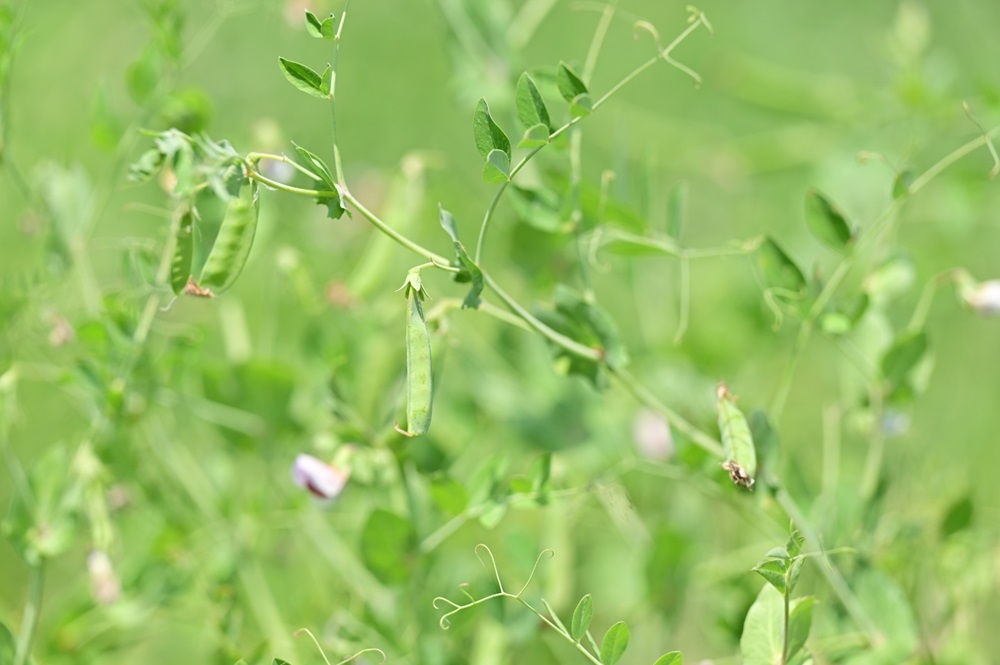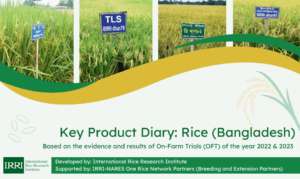by Dillip Kumar Rout, Mosharaf Hossain, and Swati Nayak
Apart from its nutritional value, the grass pea can be grown as a relay crop after rice while enough soil moisture is still available. Its ability to withstand drought and erratic rainfall patterns makes it an ideal choice for cultivation in water-stressed areas. Its robust growth and tolerance to stress contribute to its reliability as a lucrative option for farmers to cultivate in rice fallows.

Bolangir District in western Odisha is known for its vast fallow lands after the paddy harvest because of water scarcity and limited crop diversity. Recently, the Government of Odisha reached a significant milestone in building a more diverse agri-food system and improving farmer incomes and nutrition through an ambitious project targeting rice fallows across the state.
The International Rice Research Institute (IRRI), International Center for Agricultural Research in the Dry Area, World Vegetable Center formed a partnership to introduce transformative intervention on rice-legume, rice-pulse, and rice-oilseed cropping systems for vulnerable and smallholder dry land ecosystems.
A parallel amplification by the International Crops Research Institute for the Semi-Arid Tropics also played a key role in rolling out a detailed program for introducing legume, pulses, and oilseed crop cultivation on rice-fallow lands to enhance soil fertility and food and nutrition security in the region.
Re-cultivating the crop of the people
An exercise to understand the needs of targeted communities in Bolangir revealed that grass pea was a highly preferred crop in the district. Historically, grass pea was a widely grown crop Bolangir. The legume is rich in protein, fiber, and antioxidants.
Apart from its nutritional value, grass pea is a short-duration crop (65-75 days) that can be grown as a relay crop after rice while enough soil moisture is still available. The western districts in Odisha have low residual soil moisture compared to the coastal areas making shorter-duration crops highly suitable for the fallow periods. Grass peas can also withstand temperature extremes and produce reasonable yields.
Today, grass pea is often regarded as a minor crop. The lack of quality seeds and knowledge for cultivating grass peas contributed to its low popularity. Because farmers feared crop failure and minimal returns from grass peas, they either kept their land fallow or grew local varieties with negligible productivity.

Improved and safer variety
The main challenge in grass pea cultivation was the high oxalyldiaminopropionic acid (ODAP) content in indigenous grass pea varieties. If eaten in large amounts ODAP can cause a serious health problem.
As the preference for the legume remains high in Bolangir, varietal selection, positioning, and replacement of traditional and local grass pea varieties was a goal for reinvigorating the rice-grass pea cropping system in the region.
Modern breeding efforts have produced improved grass pea varieties like Prateek. Developed by the Indira Gandhi Krishi Vidyalay University, Prateek contains only 0.07-0.08 % ODAP, compared to more than 1% in traditional varieties, making it a healthier option for consumption.
Under the Comprehensive Programme on Rice Fallow Management (CPRFM), a wide demonstration showcasing the cultivation of non-paddy crops in 14 blocks spanning 5,490 hectares (ha) is underway to intensify fallow cropping, boost crop diversity, and improve profitability. The initiative also encouraged and mobilized the participation of several women farmers through active community engagement and knowledge dissemination.

Special attention was given to grass pea because it is not a popular crop cultivated during the dry season. In 2023, out of 5,490 ha suitable for grass pea cultivation, the crop was cultivated on only about 2,500 ha using local and traditional varieties. The rest were left fallowed.
The intervention led by IRRI, with support from the Department of Agriculture & Farmers’ Empowerment, expanded the cultivated area with the high-yielding Prateek variety. Under the initiative, which builds on intensive varietal and seed system intervention models for rice for rural communities and institutions and women-led groups, IRRI expanded the network and efforts for grass pea.
Prateek emerged as a best-fit variety as a sequence to wet-season rice because of its adaptability. Prateek was selected for its resilience to local agro-climatic conditions. Farmers in Bolangir have been cultivating the desi variety as part of relay cropping but experience low germination. Its ability to withstand drought and erratic rainfall patterns makes it an ideal choice for cultivation in water-stressed areas. Its robust growth and tolerance to stress contribute to its reliability as a lucrative crop option for farmers in rice fallows.
Moreover, the yield potential of Prateek is remarkable even under suboptimal conditions. It can produce an average yield of 1.4 tons/ha against only 950 tons/ha from local varieties.
Farmers who cultivated grass peas reported most of their produce would be consumed at home. Thus, protein intake will rise, addressing health and nutritional concerns. The saved income for not purchasing other pulses because of grass pea availability is also a way to consolidate household income.
Farmers also received hands-on training on sustainable agriculture practices. These include Rhizobium culture, phosphate-solubilizing bacteria, and sticky and light traps. Most farmers were not aware of these practices for non-paddy crops.
A notable achievement
Chief District Agriculture Officer Subash Chandra Behera called it a notable achievement in successful rice fallow management.
“Farmers in Bolangir have been cultivating pulses and oilseed crops during the rabi season but the area under cultivation has been limited,” Mr. Behera said. “The success of grass peas will go a long way to benefit the farmers.”
Under the CPRFM, areas under grass pea cultivation in the region are expected to increase next season as more farmers adopt Pateek as a post-paddy harvest. The immediate outcome of this initiative will be improved cropping intensity, particularly in areas affected by water scarcity where other crops may not be suitable.
The case of Prateek in Bolangir is an example of the transformative impact of agricultural interventions that address local challenges and foster sustainable development. In the coming seasons, IRRI will continue to empower farmers through demonstrations and outreach programs for managing rice fallows with crops like grass peas.
The Comprehensive Programme on Rice Fallow Management is supported by the Odisha State Government through the Department of Agriculture & Farmers’ Empowerment.







Excellent Informative story covering the acceptance of new variety of Grass pea by the farmer of Bolangir which is entirely zero cost accept the seed and the output is received high protein dal with less carbon foot print. It stems to be the low cost dal can be available under Rs 50 per kilo which can be afford by rural communities . Lots of value added product can be prepared from this dal. Thank you Swati Madam and her team for highlighting such unforgotten crops .